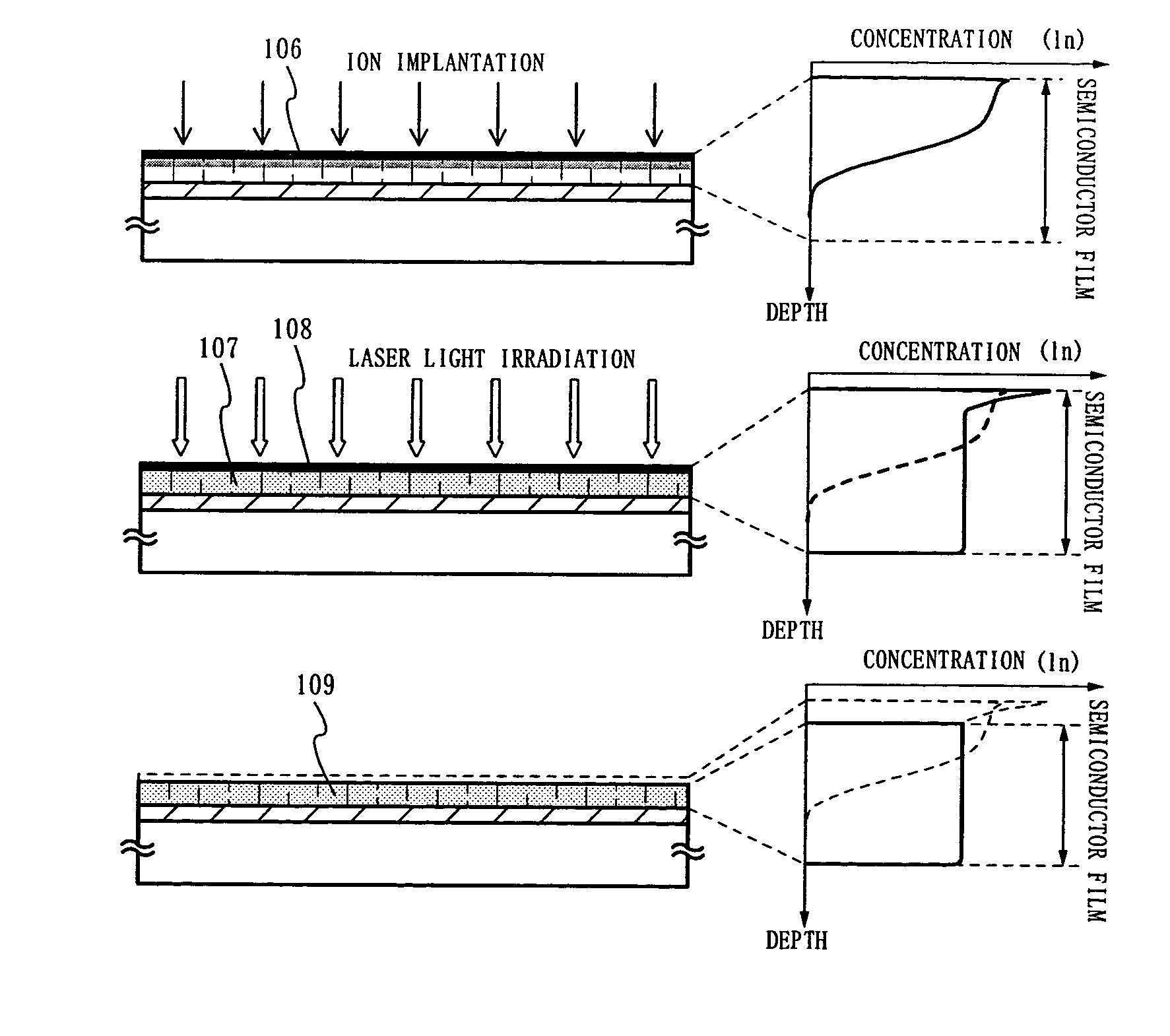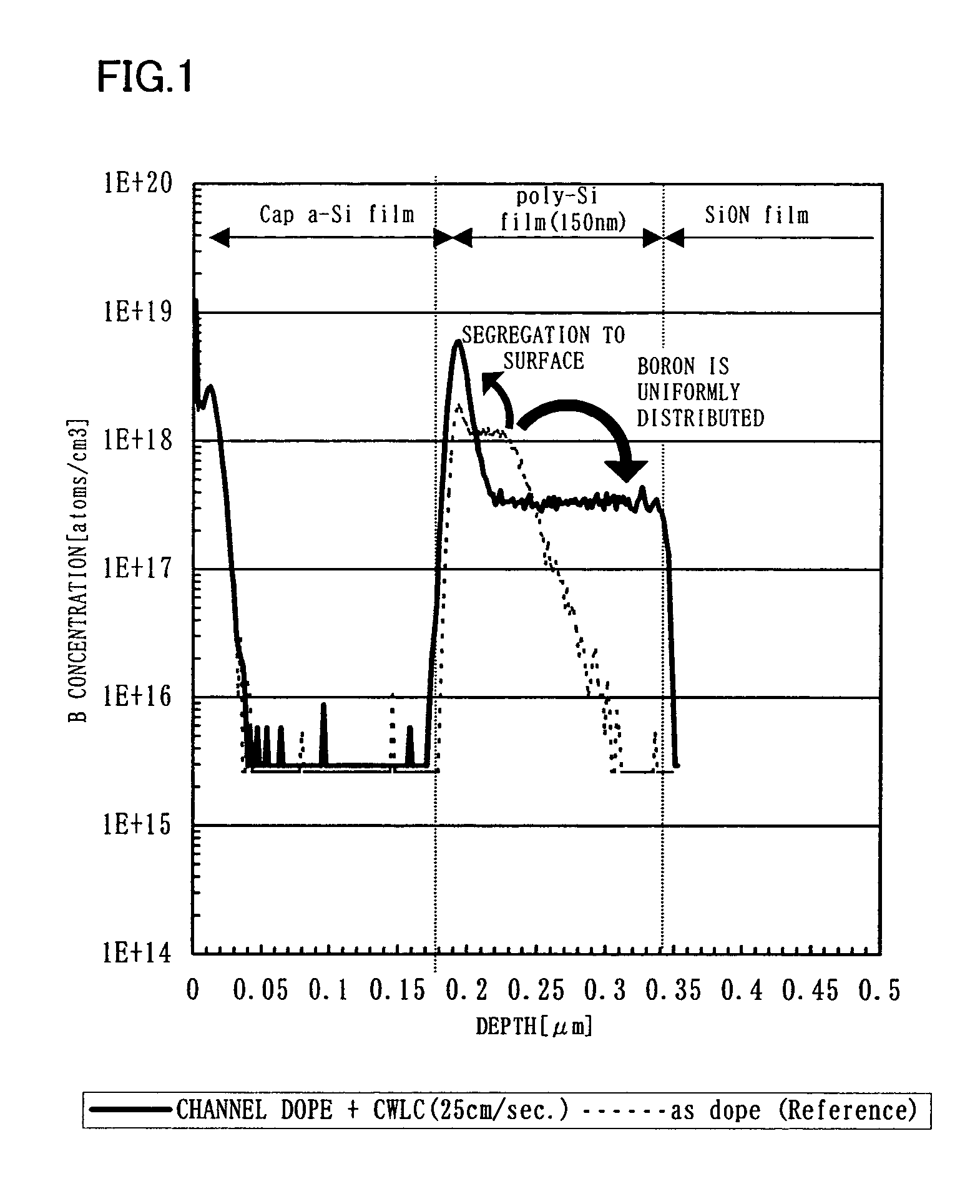Method of manufacturing a semiconductor device
- Summary
- Abstract
- Description
- Claims
- Application Information
AI Technical Summary
Benefits of technology
Problems solved by technology
Method used
Image
Examples
embodiment 1
[0048]FIGS. 7A to 7E are diagrams illustrating a method of manufacturing a semiconductor device according to Embodiment 1 of the present invention. As shown in FIG. 7A, a base insulating film 102 is formed on a substrate 101 from a single layer or a laminate of a silicon nitride film, a silicon oxide film, and a silicon nitroxide film. The material of the substrate 101 is a commercially-available glass material called non-alkaline glass such as alminosilicate glass. Alternatively, a semiconductor substrate such as a single crystal silicon substrate may be employed.
[0049]An amorphous semiconductor layer 103 is formed from an amorphous material such as silicon or silicon doped with germanium. The thickness of the amorphous semiconductor layer 103 is 60 to 200 nm, typically 150 nm. A metal-containing layer 104 contains a metal element having a catalytic action that makes it possible to crystallize the amorphous semiconductor layer at a temperature not higher than 600° C. and accelerate...
embodiment 2
[0057]FIGS. 8A to 8D are diagrams illustrating a method of manufacturing a semiconductor device according to Embodiment 2 of the present invention. As shown in FIG. 8A, a base insulating film 102 and an amorphous semiconductor layer 103 are formed on a substrate 101.
[0058]First, ions are implanted in the amorphous semiconductor layer 103 for channel doping. When ions of an impurity of one conductivity type are accelerated by electric filed and implanted into a semiconductor layer, the impurity element implanted is distributed in accordance with the acceleration voltage. With such ions implanted at 30 kV or less, the concentration in an impurity implanted region 110 peaks in the vicinity of the surface and decreases as the distance from the surface is increased to form a distribution resembling Gaussian distribution as shown in an inserted diagram of FIG. 8B. The concentration of the implanted impurity in the semiconductor layer is 1×1015 to 5×1018 / cm3 at its peak.
[0059]Thereafter, a...
embodiment 3
[0063]FIGS. 9A to 9E are diagrams illustrating a method of manufacturing a semiconductor device according to Embodiment 3 of the present invention. As shown in FIG. 9A, a base insulating film 102 and an amorphous semiconductor layer 103 are formed on a substrate 101.
[0064]First, the amorphous semiconductor layer 103 is irradiated with pulse laser light to be crystallized. The light source of the pulse laser light can be a pulse oscillation gas laser or solid-state laser Specifically, an excimer laser oscillator, a YAG laser oscillator, a YVO4 laser oscillator, a YLF laser oscillator, or the like is employable. The oscillation frequency is set to 10 to 300 Hz and the oscillation pulse width is set to 20 to 100 nsec. A region of the amorphous semiconductor layer that is irradiated with the pulse laser light is partially or entirely melted and crystallized. The resultant crystalline semiconductor film, which is denoted by 114, has an irregular surface and the largest level difference e...
PUM
 Login to View More
Login to View More Abstract
Description
Claims
Application Information
 Login to View More
Login to View More - R&D
- Intellectual Property
- Life Sciences
- Materials
- Tech Scout
- Unparalleled Data Quality
- Higher Quality Content
- 60% Fewer Hallucinations
Browse by: Latest US Patents, China's latest patents, Technical Efficacy Thesaurus, Application Domain, Technology Topic, Popular Technical Reports.
© 2025 PatSnap. All rights reserved.Legal|Privacy policy|Modern Slavery Act Transparency Statement|Sitemap|About US| Contact US: help@patsnap.com



